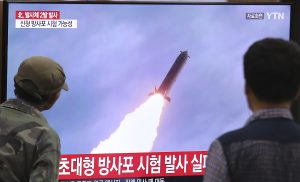On Monday, North Korea launched two short-range ballistic missiles into the Sea of Japan, South Korea’s Joint Chiefs of Staff said. The launches are Pyongyang’s first in 2020, coming after a three month break in missile testing that endured from late-November 2019.
According to South Korean authorities, the two ballistic missiles were fired from near Wonsan, a city on North Korea’s east coast favored by leader Kim Jong Un for missile launches. The launches took place in quick succession, with just 20 seconds between them.
South Korean authorities additionally reported that the missiles flew to a range of 240 kilometers each and reached an in-flight apogee of around 35 kilometers. The range and apogee figures closely match that demonstrated by what North Korea described previously as a “large-caliber” multiple launch rocket system (MLRS), first tested in 2019.
South Korean authorities suggested that analysis of the missiles launched on Monday was ongoing and that there were similarities to missiles tested in the previous year. “South Korean and the U.S. intelligence authorities are analyzing their type. We found some similarities in features between what it fired today and those launched last year,” a South Korean Joint Chiefs of Staff officer told reporters in Seoul.
2019 marked a busy year for North Korean missile testing, with 26 ballistic missiles tested across 13 separate launch events. North Korea tested four new types of short-range ballistic missile systems and introduced a new submarine-launched ballistic missile, the Pukguksong-3, last year.
Monday’s test came days after North Korean leader Kim Jong Un oversaw a “joint strike” drill, thought to have also taken place near Wonsan. Those drills came after reports that the United States and South Korea had canceled plans for their springtime exercises amid concerns about the novel coronavirus, or COVID-19.
North Korean state media has openly described COVID-19 as a major concern to the country, but Kim Jong Un’s decision to push ahead with military exercises — including ballistic missile launches — may signal a desire to set Pyongyang’s military practices apart from that of South Korea and the United States.
In previous years under Kim Jong Un, North Korea has regularly conducted ballistic missile launches in March; in certain years, the launches have been explicitly designed to respond to joint military exercises by the United States and South Korea. Pyongyang is highly critical of those exercises, often presenting them as a ruse for an invasion of its territory.
South Korean authorities are maintaining readiness amid concern about additional missile launches. “Our military is monitoring the situation in case of additional launches and maintaining a readiness posture,” South Korea’s Joint Chiefs of Staff said.
Pyongyang’s state media is expected to report on the nature of Monday’s missile tests early on Tuesday morning.

































